Designing an app for a world-first study to improve wellbeing and help reduce stress in students
Project: Vibe Up app
Collaborators: Black Dog Institute and A2I2 at Deakin University
Role: UX/UI Designer
Date: October 2020 – August 2021
Study webpage ︎︎︎
Collaborators: Black Dog Institute and A2I2 at Deakin University
Role: UX/UI Designer
Date: October 2020 – August 2021
Study webpage ︎︎︎

Background
More than 1 in 4 university students experience high-stress levels that negatively impact their studies, relationships, and daily lives. Vibe Up is a world-first study aiming to change this at scale.
The Black Dog Institute are conducting an AI-response-adaptive randomised controlled non-inferiority trial of smartphone app-delivered self-care strategies for psychological distress in university students.
This smartphone app for university students aims to reduce distress and improve mental wellbeing through a brief two-week intervention of mindfulness, physical activity, or sleep hygiene. Although the three interventions use different treatment strategies, they are loosely matched on time and effort required by participants. The three interventions will be compared to an active control condition, in which participants are asked to monitor their mood throughout the day.
The Black Dog Institute are conducting an AI-response-adaptive randomised controlled non-inferiority trial of smartphone app-delivered self-care strategies for psychological distress in university students.
This is a novel approach that has only recently been introduced to limited health settings, in skin cancer and improving physical activity. It has yet to be trialled within the mental health realm.
Dr Leonard Hoon said, Senior Technical Product Manager at A2I2, and Vibe Up project lead.
Through Vibe Up, we aim to provide a richer and more streamlined healthcare experience, to help people get the most effective treatment as fast as possible.
Head of Clinical Research at the Black Dog Institute, and Vibe Up Study Lead, Associate Professor Jill Newby
This smartphone app for university students aims to reduce distress and improve mental wellbeing through a brief two-week intervention of mindfulness, physical activity, or sleep hygiene. Although the three interventions use different treatment strategies, they are loosely matched on time and effort required by participants. The three interventions will be compared to an active control condition, in which participants are asked to monitor their mood throughout the day.
Design challenge
The Research team engaged the Design team to offer support to manage and lead UX design process to deliver an end-to-end experience that enables participants to participate in the study.
Students are required to complete a screening survey in order to determine if they are eligible for the study.
Participants will be required to spend up to 30 minutes per day engaging with the app and its activities.
The study will last 3-4 weeks with the overall time commitment required for study activities, spread over that time, is about 8 hours.
Questions asked by the research team:
Students are required to complete a screening survey in order to determine if they are eligible for the study.
Participants will be required to spend up to 30 minutes per day engaging with the app and its activities.
The study will last 3-4 weeks with the overall time commitment required for study activities, spread over that time, is about 8 hours.
Questions asked by the research team:
- How might we get students to stick with the app for 4 weeks?
- How might we get students to do the app tasks (questionnaires and interventions)?
- How might we minimise perceived participant burden?
- How might we get people to change their behaviour with the interventions?
- How might we deliver feasible design proposals to Deakin tech team?

Approach
In order to develop an engaging and trauma-informed experience for university students while meeting the requirements of the study design, a deep understanding of daily habits and device usage was initially established. In order to endear the app to participants, we then needed to understand how to motivate and streamline their experiences during the study period.
![]()
Discovery Phase:
Identify and contextualise opportunities within the problem-space, 4 rounds of 1:1 online testing with 34 users recruited through Askable platform. Co-design sessions were run to develop concepts alongside surveys and card-sorting activities.
Synthesis phase:
A collaborative process of sense-making of all the gathered data which results in a strategy for user experience and creative direction.
Design and development phase:
Testable prototypes are produced at this phase as a result of the solutions developed from the previous phases. Collaboration between the design, research and tech teams are important to ensure feasibility and correct implementation.
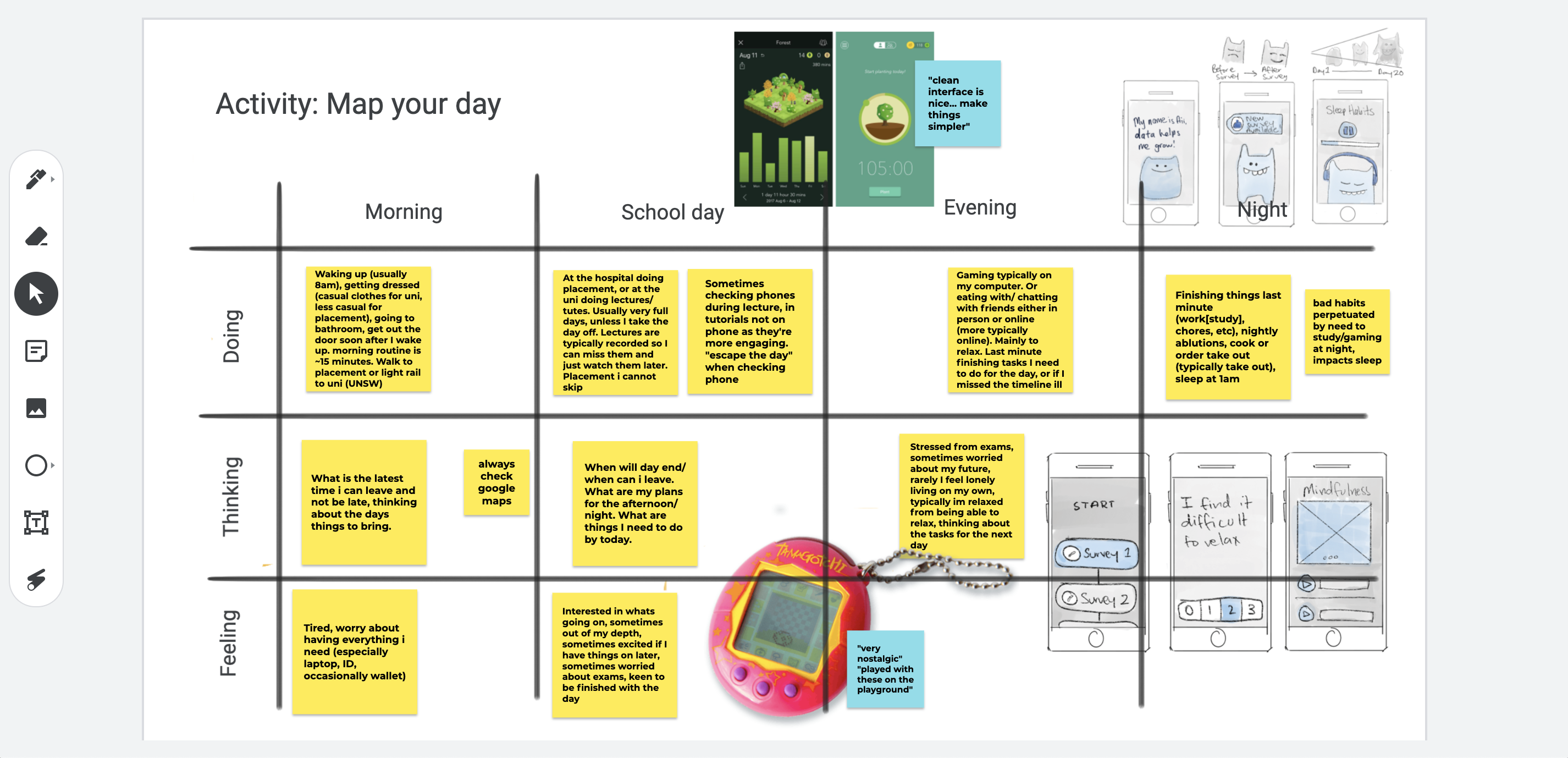
Discovery Phase:
Identify and contextualise opportunities within the problem-space, 4 rounds of 1:1 online testing with 34 users recruited through Askable platform. Co-design sessions were run to develop concepts alongside surveys and card-sorting activities.
Synthesis phase:
A collaborative process of sense-making of all the gathered data which results in a strategy for user experience and creative direction.
Design and development phase:
Testable prototypes are produced at this phase as a result of the solutions developed from the previous phases. Collaboration between the design, research and tech teams are important to ensure feasibility and correct implementation.
Outcome
The study is currently in progress with mini-trials begining from November 2021 and continuing until November 2022.
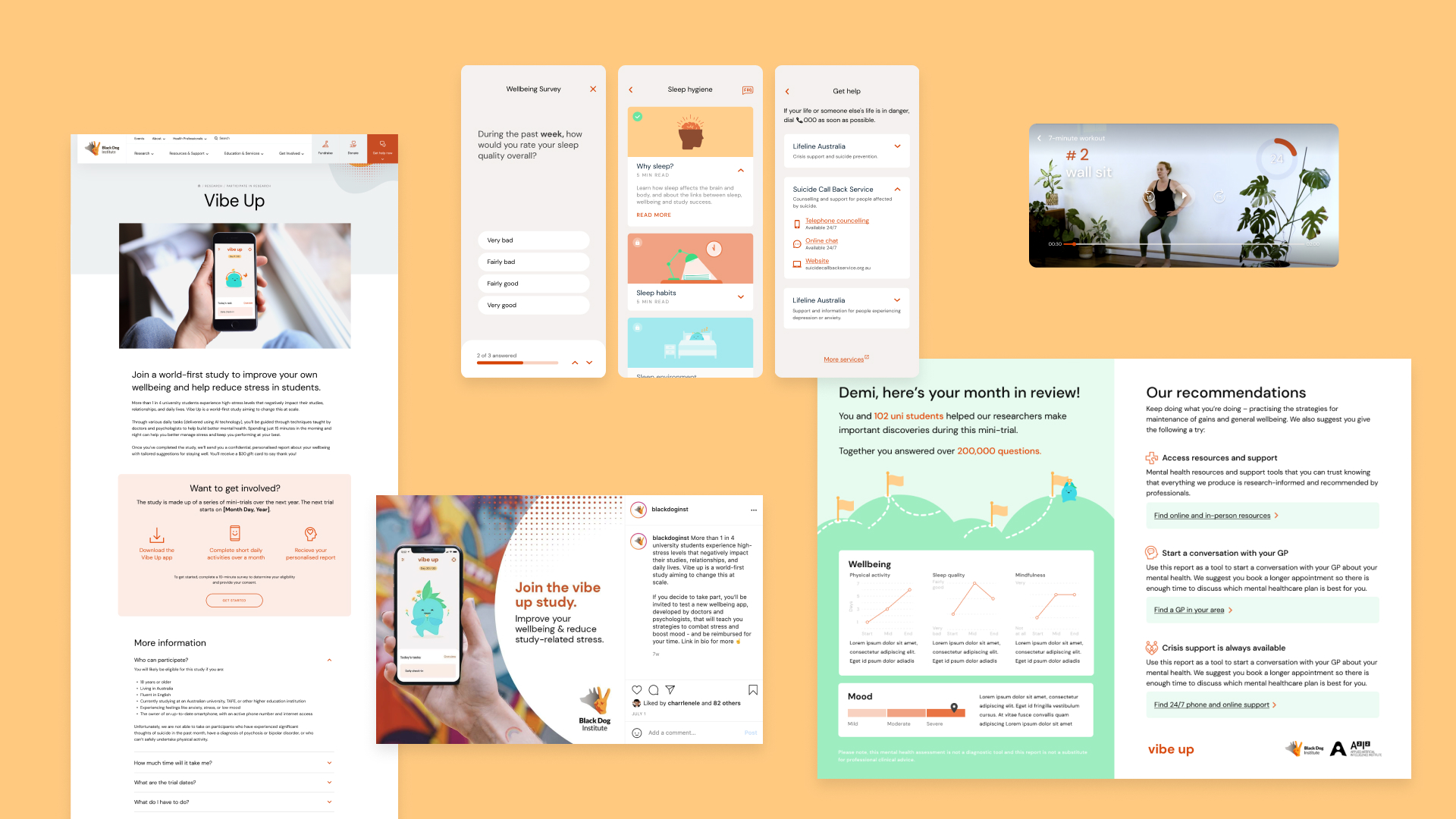
Design team
Adryon Joubert-de Villiers, Design Manager
Marya Bautista, UX/UI Designer
Jenny Vuu, Design Researcher
Matt Lee, Illustrator and Animator
Marya Bautista, UX/UI Designer
Jenny Vuu, Design Researcher
Matt Lee, Illustrator and Animator
Designing an online triage tool for people in need of legal aid in New South Wales
Project: Online triage tool (Alpha stage)
Partner organisations: Legal Aid NSW and Code for Australia
Role: UX Designer
Date: February 2020 – August 2020
Partner organisations: Legal Aid NSW and Code for Australia
Role: UX Designer
Date: February 2020 – August 2020

I feel like it would help us a lot if they did something to reduce panic... We want our hand to be held during the stressful period. Past Legal Aid NSW Client
Project background
Legal Aid NSW is in the process of designing improved ‘triage’ practices to ensure that clients are channeled to the right level of service at the right time and that disadvantaged people do not miss out on the services they need.
The Online Triage Tool aims to increase the capacity of LANSW to connect clients with the correct services and resources as soon as possible. This results in less re-directions, increased client capability to understand their legal issues and more resources available for urgent matters.
This project engaged Code for Australia to undertake the Discovery and Alpha stages to present innovative recommendations. They worked alongside LANSW to examine the challenge in a new light, build capability, and create open source and human-centered technology.
The Online Triage Tool aims to increase the capacity of LANSW to connect clients with the correct services and resources as soon as possible. This results in less re-directions, increased client capability to understand their legal issues and more resources available for urgent matters.
This project engaged Code for Australia to undertake the Discovery and Alpha stages to present innovative recommendations. They worked alongside LANSW to examine the challenge in a new light, build capability, and create open source and human-centered technology.
Project goals
- Allow LANSW to focus more intensively on high priority clients, reduce call waiting times, call “drop-outs” an multiple re-directions.
- Gain a clear understanding of various client needs and challenges around online entry to LANSW services, accessing and engaging online about their legal matters.
- Low-impact and out of scope clients are supported through online self-service. High-impact and complex matters are quickly matched with the correct service.
- Address client expectations and improve customer experience by streamlining services through digital delivery
- Bring the voice of the client to the design of an online triage tool that improves their capacity to understand their legal problem.
Discovery phase

The Discovery phase was an intensive research period undertaken at the start of a project. The objective of this period was to identify and contextualise the problem space.
This research identified the client and business needs in order for the team to align with the shared vision. It follows a broad and solution-agnostic mindset in order to prepare for technical exploration that produces evidence-based opportunities.
![]()
Key findings from 1:1 interviews with clients and staff:
This research identified the client and business needs in order for the team to align with the shared vision. It follows a broad and solution-agnostic mindset in order to prepare for technical exploration that produces evidence-based opportunities.
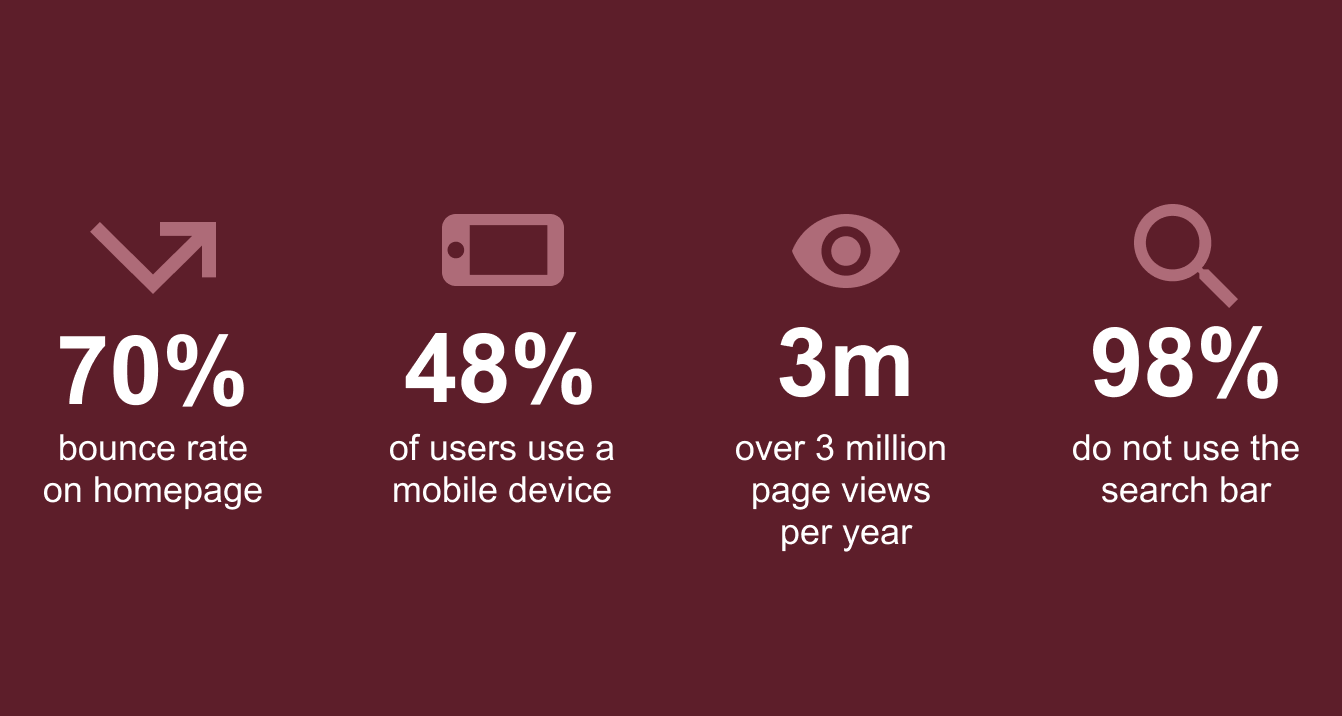
Key findings from 1:1 interviews with clients and staff:
A lot of cultural stigma gets overlooked... lots of things can't be discussed or are difficult to explain. It was easier to write it down for the lawyer. It was a relief not to verbally express that. Past Legal Aid NSW Client
I’m homeless and I don’t have any technology, but I can do my own research. I can't go to the library because of my privacy concerns. I need to know that my resources are secure and safe. Past Legal Aid NSW Client
It must be phone compatible... I'll be on the phone to clients and telling them how far to scroll down on websites. Client Service Officer, Head Office
People are calling and links are sent because they can't find information on the website. LawAccess site visit
It's important that we make sure the educational resources we distribute to clients utilise Easy English and Plain Language. We also use “soft language” when speaking to clients who are experiencing sensitive issues. Solicitor, Community Legal Education
Workshops

A workshop run with solicitors and paralegals to outline and validate common legal problems and how their triage logic could be mirrored online.
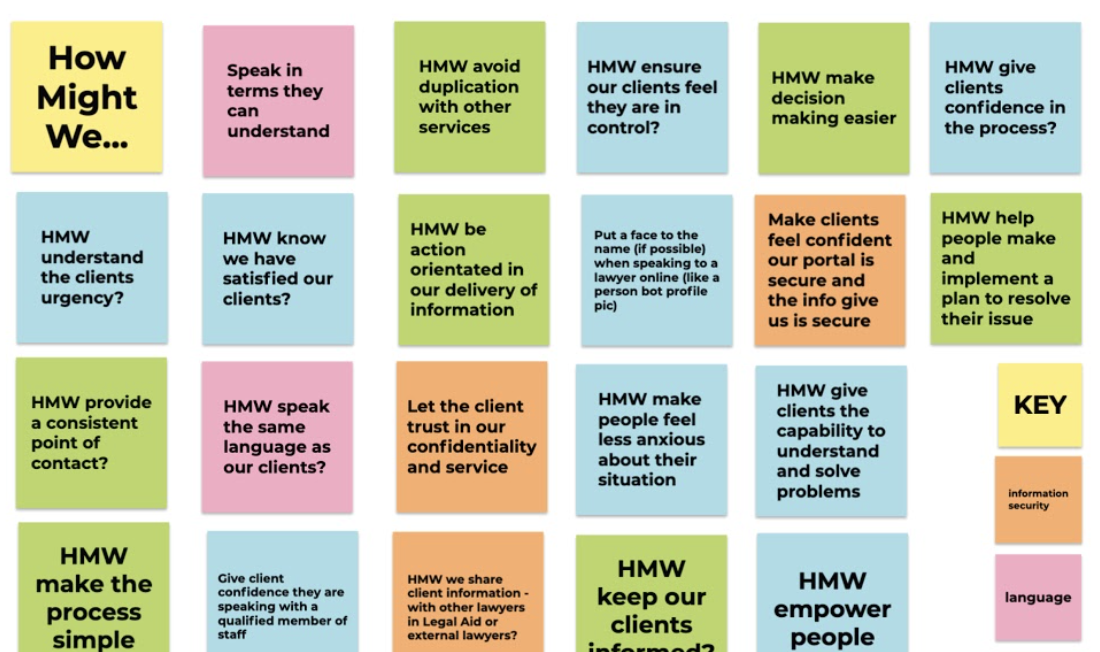
A virtual brainstorming session which included the Client Services Unit, IT and Community Legal Education teams to help re-frame their frustrations and goals into potential opportunities.
Synthesis phase
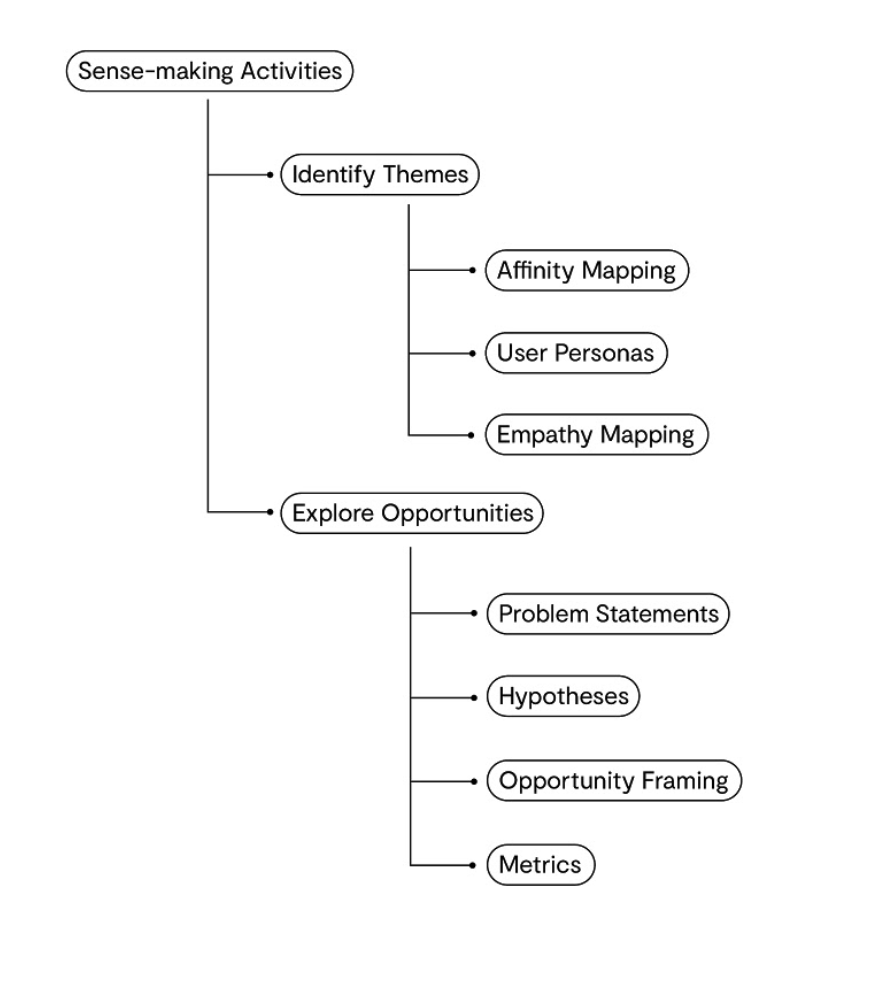
The Synthesis phase was a collaborative process of sense-making, which leads to creating a coherent summary of all the data gathered during the research phase.
This stage was about finding emerging themes and asking specific question as we converged to explore hypotheses and potential solutions.
Some of our opportunity framing questions and themes were:
Affinity mapping of client interview responses allowed our team to map out all the gathered findings. Themes were identified and grouped, then presented as User Personas to help develop solutions.
Journey Map
![]() Future state roadmap
Future state roadmap
![]()
This stage was about finding emerging themes and asking specific question as we converged to explore hypotheses and potential solutions.
Some of our opportunity framing questions and themes were:
- Language — How might we design a tool that is understood by users who are unfamiliar with legal jargon?
- Security — How might we ensure trust in our service and protection of personal information?
- Customer Experience — How might we help clients feel confident and empowered to seek online information themselves?
- Accessibility — How might we design a tool that provides user-friendly information and features that suppor different needs and abilities?
Affinity mapping of client interview responses allowed our team to map out all the gathered findings. Themes were identified and grouped, then presented as User Personas to help develop solutions.
Journey Map
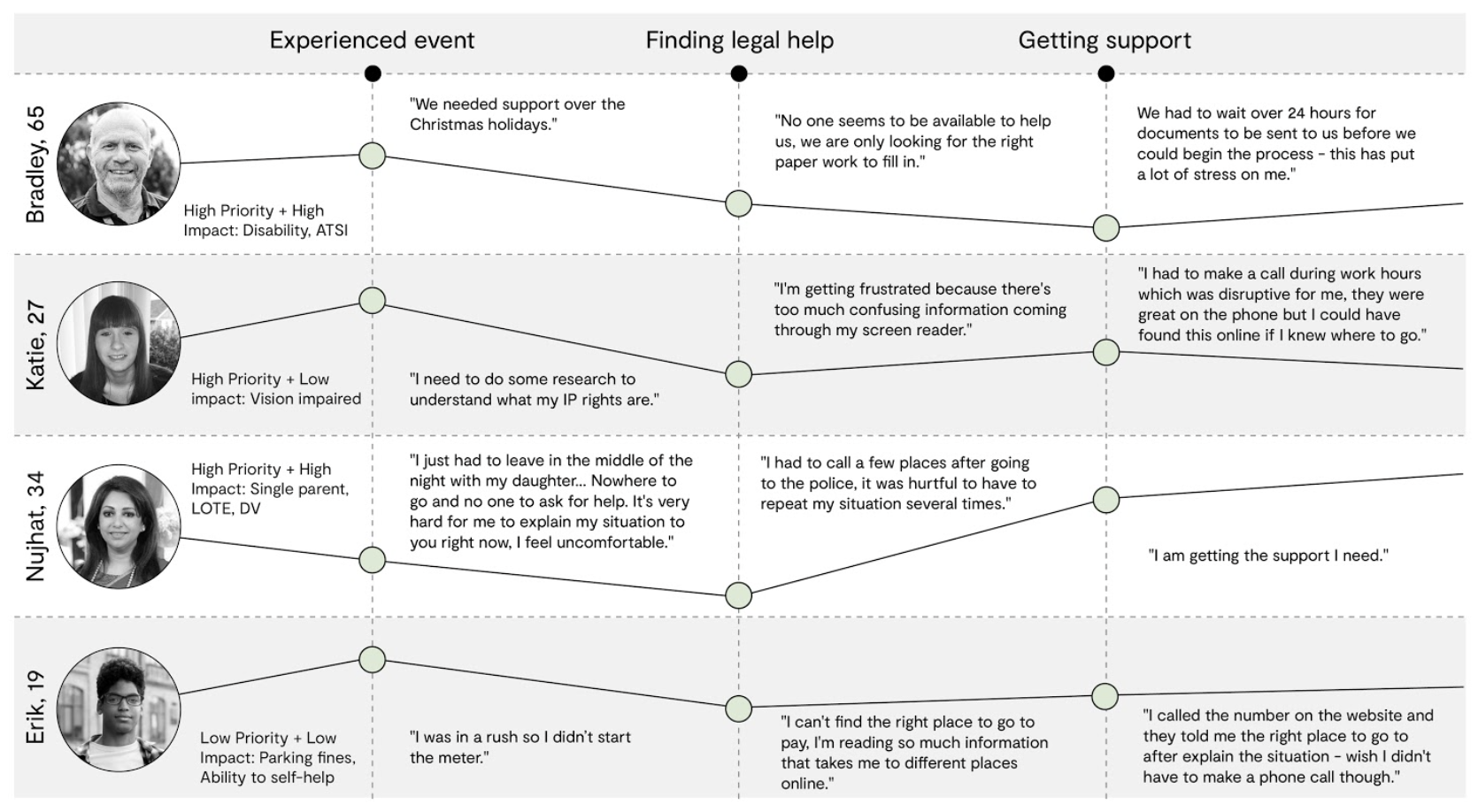 Future state roadmap
Future state roadmap
Alpha phase
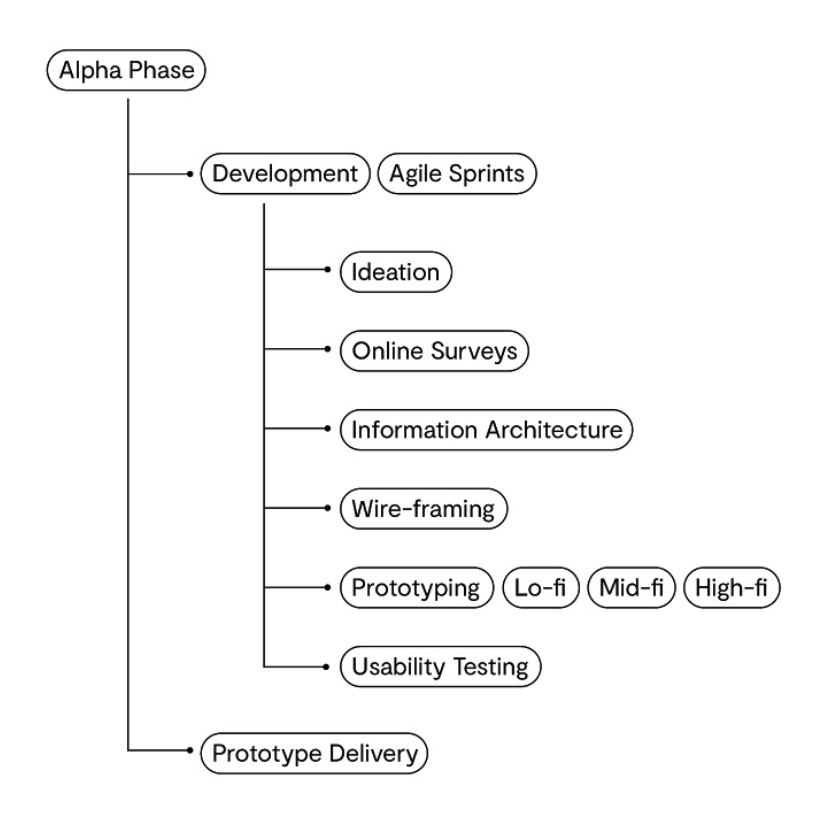
This phase marked the start of the development and ideation process to present solutions to the opportunities identified in the previous phase.
Two-week Agile Sprints were conducted to ensure constant iteration alongside client and stakeholde collaboration to deliver prototypes.
Further research and usability testing was undertaken to validate hypotheses as well as gather constructive
feedback through surveys and usability testing.
Design and development of potential technical solutions were then explored to present interactive prototypes based on the results of user research.
Two-week Agile Sprints were conducted to ensure constant iteration alongside client and stakeholde collaboration to deliver prototypes.
Further research and usability testing was undertaken to validate hypotheses as well as gather constructive
feedback through surveys and usability testing.
Design and development of potential technical solutions were then explored to present interactive prototypes based on the results of user research.
Outcomes
The deliverables and prototypes of this project were presented to the CEO and key stakeholders of Legal Aid NSW. The Beta phase of this project will commence at a later date.
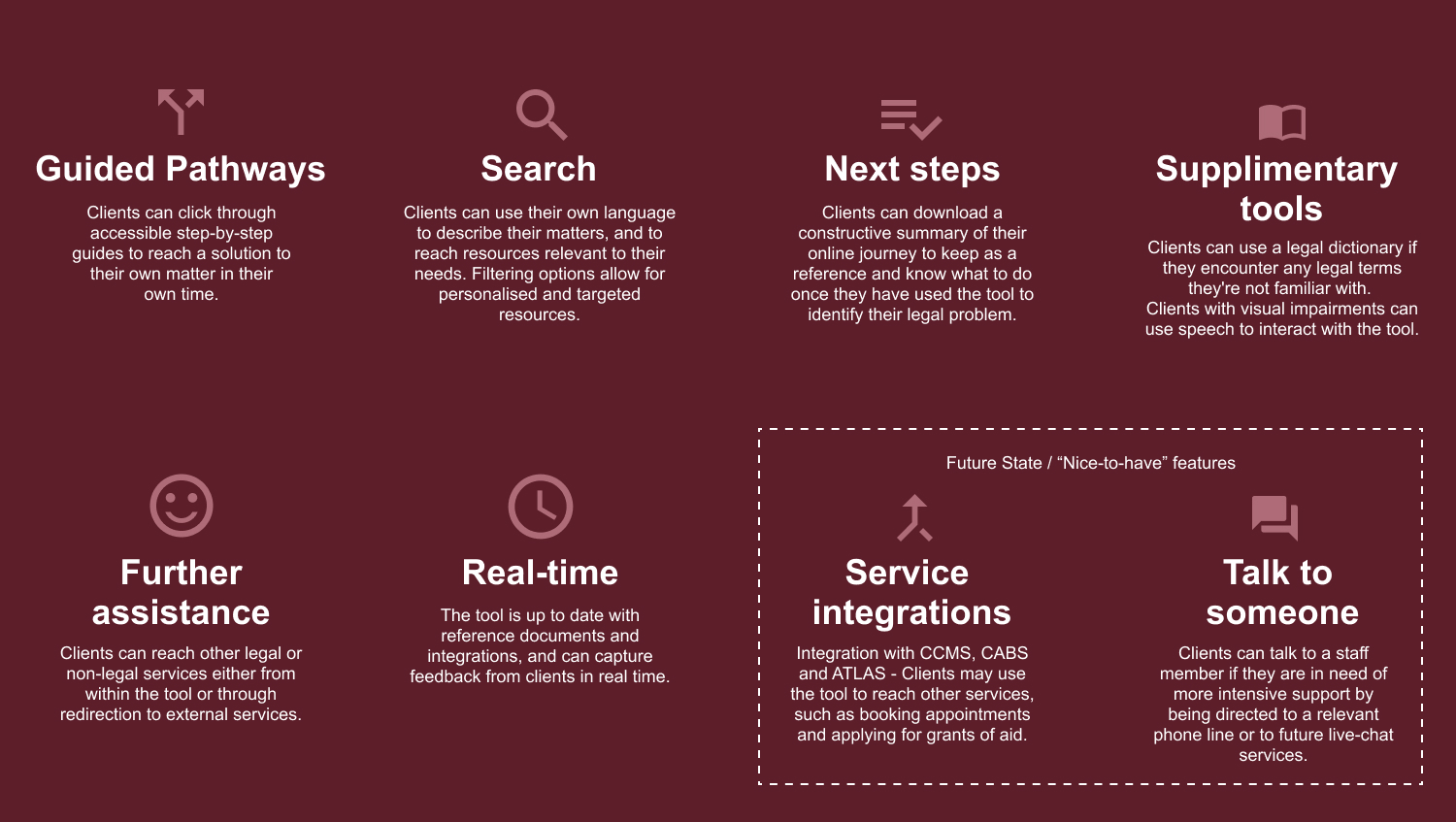

View the full case study ︎︎︎
Project team
Adrian Rodriguez, Developer
Marya Bautista, UX designer
Vlad Tudor, Data scientist
Marya Bautista, UX designer
Vlad Tudor, Data scientist
Feedback from LANSW
In what ways / areas did Marya excel? What were Marya’s strengths?
What are some areas Marya could work on or develop?
- Marya took on a project lead role anda lot of the project management on behalf of the team. She kept the project flowing and led the daily stand-ups.
- Documentation and presentation of work was of a high standard
-
Very receptive to feedback and requests for change, flexible
-
Very easy to work with, personable, good communication skills, good listener
- Resilience under pressure and when covid started / looking at different ways of working remotely. Problem solving was great – holding remote session with clients etc
- Working with different applications and exposing the Legal Aid team to these (jamboard, Trello etc)
- Marya spent a huge amount of time and effort to make sure things got done and went above and beyond what was expected of her and this was greatly appreciated
What are some areas Marya could work on or develop?
- Time management of meetings an issue at first but this was improved / addressed
- We find it hard to think of other areas for Marya to develop. She showed growth throughout the project and it was fantastic to see her confidence grow.
Transforming online access to legal help for artists and creatives across Australia
Project: Digital transformation (Stage 1)
Partner organisations: Arts Law Centre of Australia and Code for Australia
Role: UX Designer
Date: August 2021 – December 2021 (4.5 months)
Partner organisations: Arts Law Centre of Australia and Code for Australia
Role: UX Designer
Date: August 2021 – December 2021 (4.5 months)
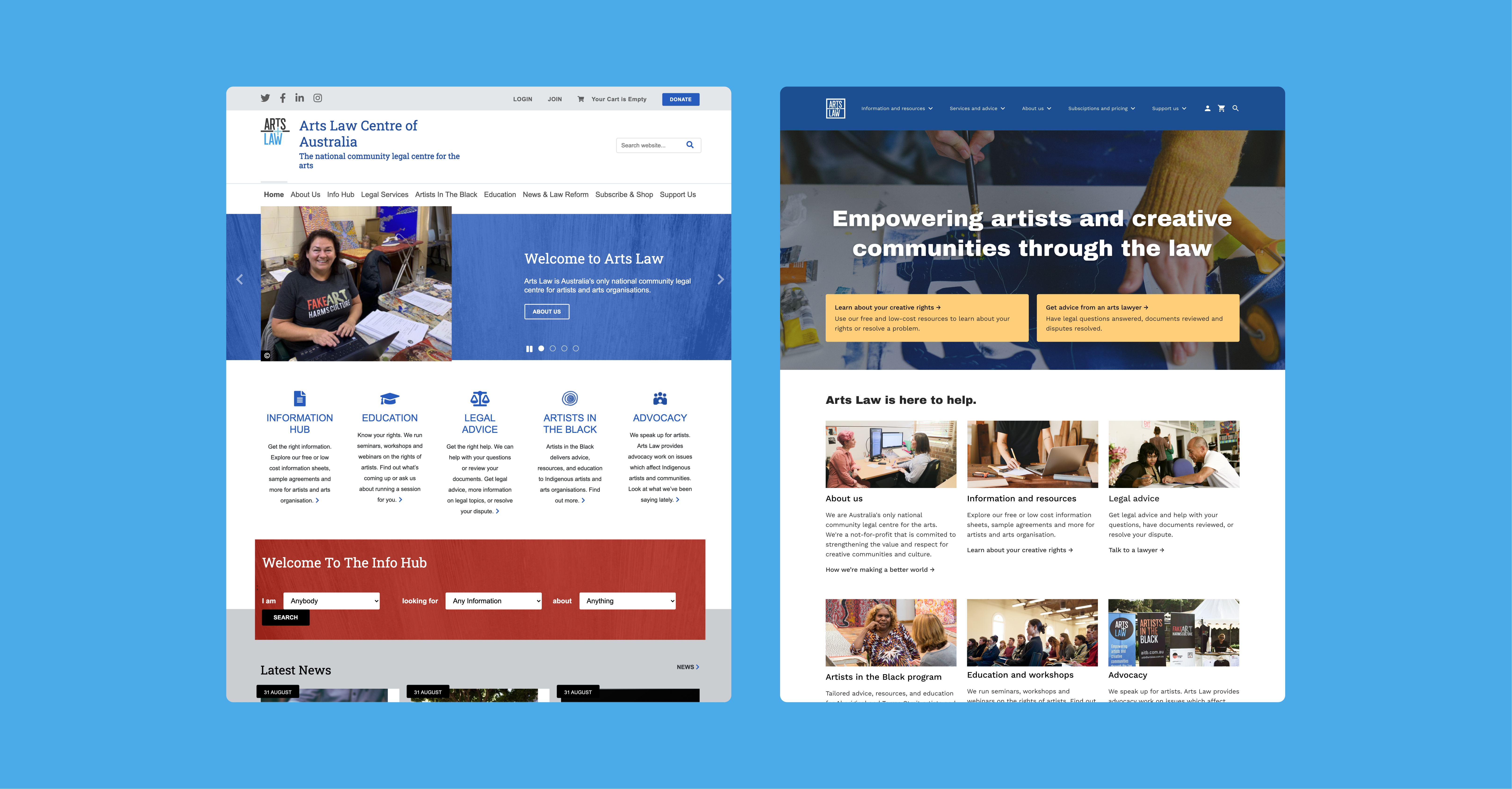 Image of Arts Law home page in August (L) and image of the homepage in December (R)
Image of Arts Law home page in August (L) and image of the homepage in December (R)
Project background
Arts Law is Australia’s independent national community legal centre for the arts, a not-for-profit company limited by guarantee.
They provide free or low cost specialised legal advice, education and resources to Australian artists and arts organisations across all art forms, on a wide range of arts related legal and business matters. Arts Law’s Artists in the Black program delivers targeted services to Aboriginal and Torres Strait Islander artists nationally.
![]()
Donna Robinson (Arts Law lawyer) with artists screen printing in studio at Yarrabah art centre. Photo by Bernie Singleton 2021 on the Arts Law website ︎︎︎
Our team at Code for Australia partnered with Arts Law to deliver a strategic roadmap and tech recommendations along with an MVP website showcasing these solutions with a focus on helping their clients find information easily.
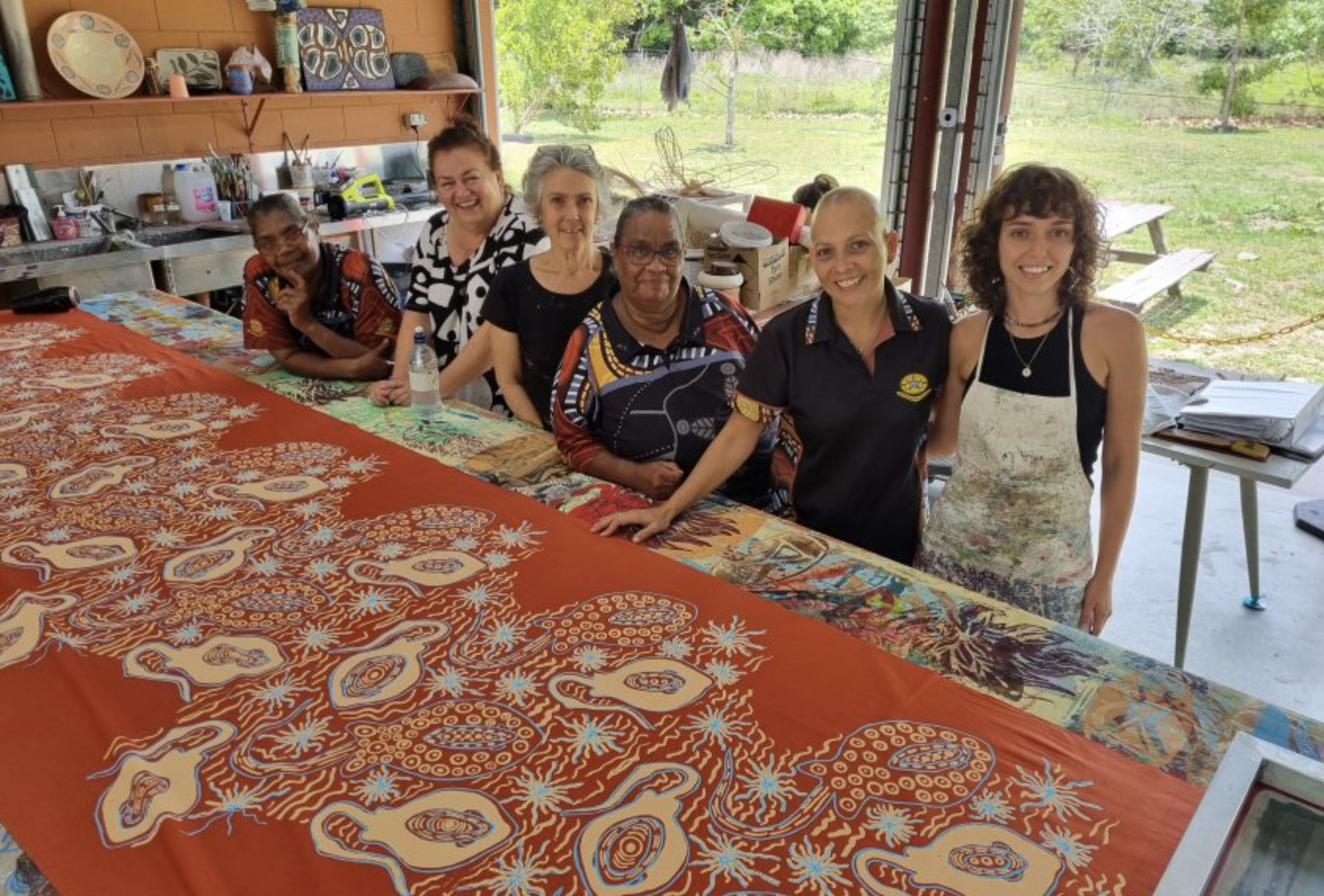
Donna Robinson (Arts Law lawyer) with artists screen printing in studio at Yarrabah art centre. Photo by Bernie Singleton 2021 on the Arts Law website ︎︎︎
Our team at Code for Australia partnered with Arts Law to deliver a strategic roadmap and tech recommendations along with an MVP website showcasing these solutions with a focus on helping their clients find information easily.
Strategy phase
Our team began this project by immersing ourselves in the opportunity space of the Arts Law digital ecosystem. We started by building a service blueprint of the current Arts Law experience and filled in the gaps by conducing research with artists, staff and investigating the systems in place.
We presented our findings at a staff prioritisation workshop where we selected key solutions to build during our engagement that were high impact and feasible to deliver with the short engagement.
High impact solutions chosen:
We presented our findings at a staff prioritisation workshop where we selected key solutions to build during our engagement that were high impact and feasible to deliver with the short engagement.
High impact solutions chosen:
- Guided pathways to improve navigability of the wide-range of resources available online
- Redesign of the Legal Query Form
- Menu restructure
- Replacement of search bar
- MVP redesign and restructure of homepage
Original Legal Query form to apply for Arts Law services (L) Guided pathways implemented with a mobile-first approach (R)
![]()

The LQF is the form that manages intake of clients online, however, last year only 2,758 were able to find the page with a 58.2% bounce rate.
Google analyticsLegal query form - my first impression is that it is pretty daunting. Having both an overview but being guided is preferable.
Interview with artistOriginal Info Hub used to find information on the website (L) Guided pathways implemented with a mobile-first approach (R)
![]()

Artists don’t know what search terms to use or what legal words to use.
Arts Law staff memberThe Info Hub search results are too numberous and overwhelming. The results are also mismatched with the search query.
Interview with artistDelivery phase
Our team had to ensure that these solutions could be implemented into the existing Wordpress site which was supported by Salesforce in the backend. Due to the 1000+ resources available and recorded client cases, we were not able to use imporoved technology at this phase which meant that all solutions needed to be able to be retro-fitted and supported by the existing systems.
Project deliverables:
![]() Digital content and style guide
Digital content and style guide
![]()
Service blueprint
Solutions that we were infeasiable to be built for this engagement where still prototyped as they were deemed high-impact. One key design concept that was handed over for development at a later date was the redesign of the Artists in the Black homepage.
Through interviews with Indigenous creatives and subject matter experts we learnt that “artists are without a doubt missing out on services” and it was unanimously unclear what was being offered.
One Aboriginal artist mentioned that “we’ve always been taught by sight - use visuals or videos” and that younger people often help Elders with technology.
As a result, the proposed website favours visuals embedded in buttons with an animated video explaining the services available with multiple language options.
Project deliverables:
- Launch of a “Minimum Viable Product” solution during the engagement
- Ongoing iteration in response to user testing and feedback
- Documentation of developed solutions for handover to Arts Law and supporting resources
- Execution of suitable support and maintenance plan for the ongoing management of the developed solutions
- The final deliverable will be the final iteration of the Arts Law website
 Digital content and style guide
Digital content and style guide
Service blueprint
Solutions that we were infeasiable to be built for this engagement where still prototyped as they were deemed high-impact. One key design concept that was handed over for development at a later date was the redesign of the Artists in the Black homepage.
Through interviews with Indigenous creatives and subject matter experts we learnt that “artists are without a doubt missing out on services” and it was unanimously unclear what was being offered.
One Aboriginal artist mentioned that “we’ve always been taught by sight - use visuals or videos” and that younger people often help Elders with technology.
As a result, the proposed website favours visuals embedded in buttons with an animated video explaining the services available with multiple language options.
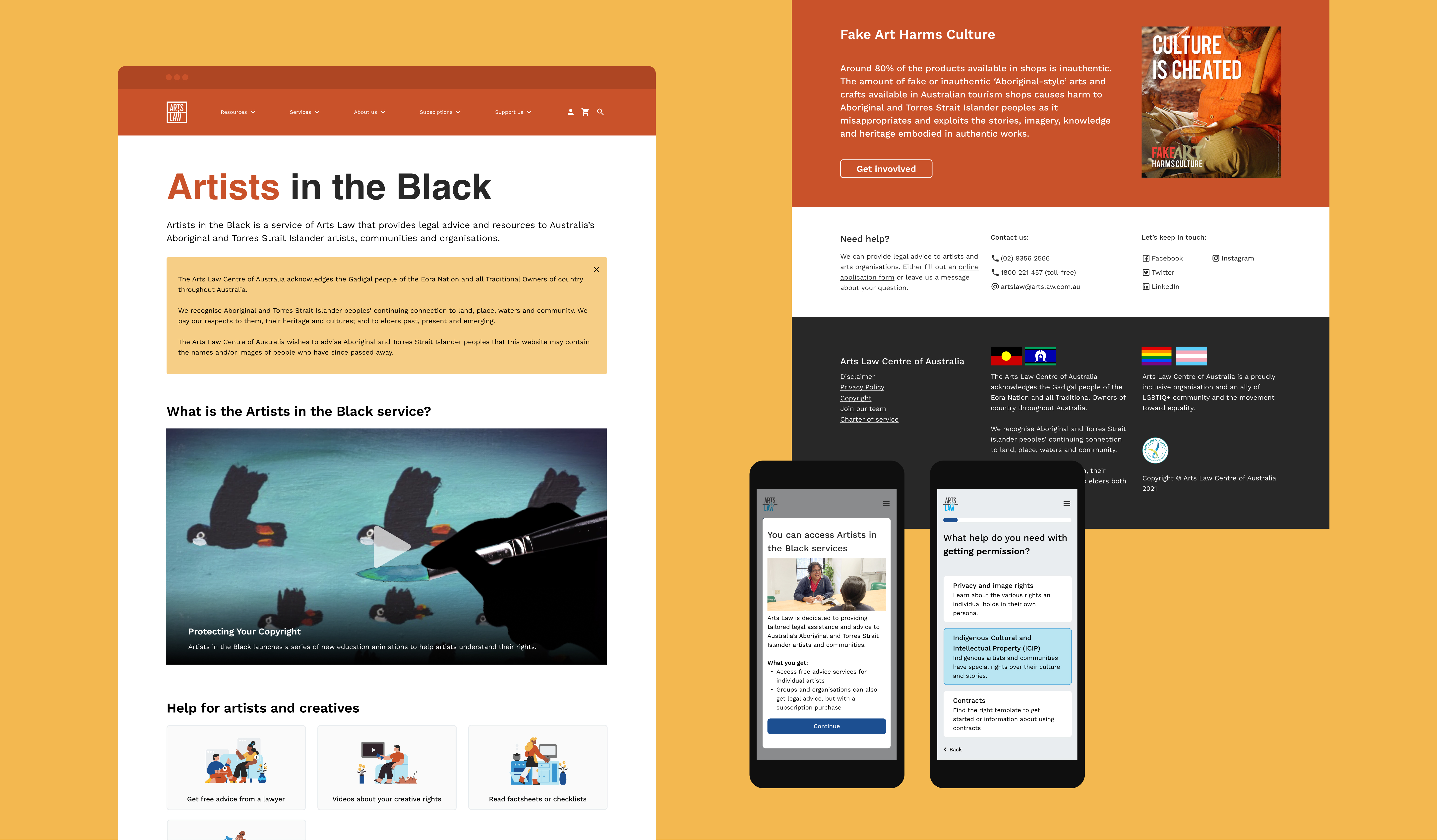
Concept for redesign of Artists in the Black homepage
Project team
Cédric Quenette, Developer
Kate Currie, Developer
Marya Bautista, UX Designer
Kate Currie, Developer
Marya Bautista, UX Designer
Making a succulent propagation system for the urban home
Project: “Sol Terra”
Course: B. Industrial Design at Monash University
Date: Semester 1, 2016
Product video ︎︎︎
Course: B. Industrial Design at Monash University
Date: Semester 1, 2016
Product video ︎︎︎
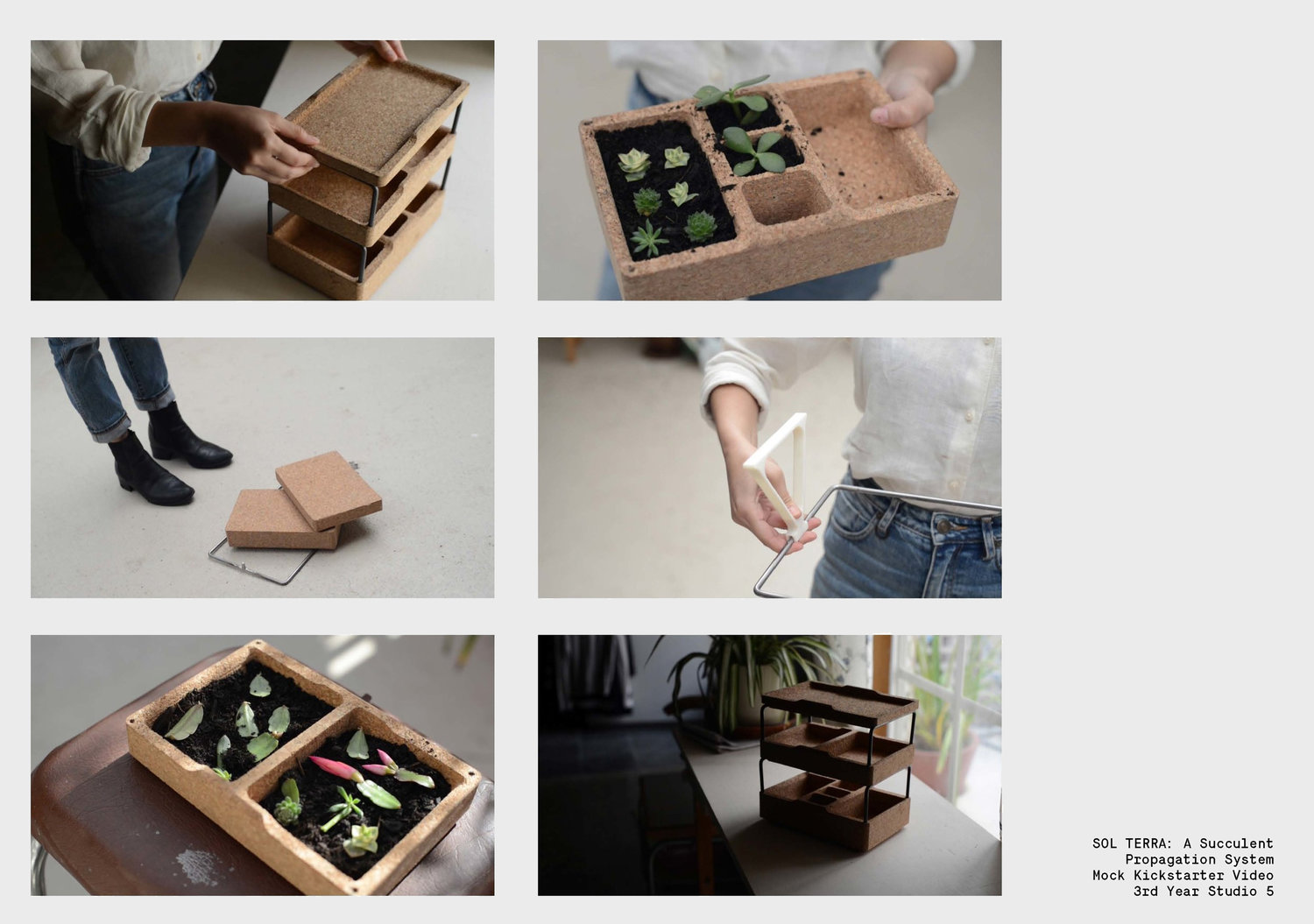
Sol Terra is a three-stage proagation system for succulent plants. It targets the Urban Gardener: the gardener without a garden.
Terra enables propagation and growing to be centralised into a neat and space-saving process.
Construction: cork, steel and CNC milling.
Terra enables propagation and growing to be centralised into a neat and space-saving process.
Construction: cork, steel and CNC milling.